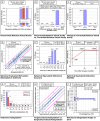One-Year Visual and Refractive Outcomes of SmartPulse® Technology in Transepithelial Photorefractive Keratectomy for Myopic and Astigmatic Patients
- PMID: 39458130
- PMCID: PMC11508999
- DOI: 10.3390/jcm13206182
One-Year Visual and Refractive Outcomes of SmartPulse® Technology in Transepithelial Photorefractive Keratectomy for Myopic and Astigmatic Patients
Abstract
Background/Objectives: This study aims to evaluate the efficacy, safety, and predictability of Transepithelial Photorefractive Keratectomy (TPRK) using the SmartPulse® technology excimer laser for the correction of myopia and myopic astigmatism, assessing visual and refractive outcomes over a one-year follow-up period. Methods: This retrospective cohort study analyzed data from patients who underwent TPRK at the Ophthalmology Department-"Victor Babes" University of Medicine and Pharmacy in Timisoara (Romania), between January 2019 and June 2023. The procedure was performed using the SmartPulse® Technology of the SmartSurfACE AMARIS 750S excimer laser (SCHWIND eye-tech-solutions, Kleinostheim, Germany). Preoperative assessments included visual acuity, refraction, and corneal measurements, with postoperative evaluations conducted for up to 12 months. Results: This study included 92 eyes from 46 patients (mean age 29.02 years, 63% male). At 12 months post-op, 100% achieved UDVA 20/25 or better, with an efficacy index of 1.01. Refractive accuracy was 96% within ±0.50 D of the target and astigmatism ≤ 0.50 D in 99% of eyes. The safety index was 1.01. Corneal haze occurred in 8.70% of eyes and was effectively managed with dexamethasone drops. Conclusions: TPRK with the SmartPulse® technology excimer laser demonstrated high efficacy and safety in correcting myopia and myopic astigmatism, achieving stable visual outcomes over one year. The procedure also showed excellent predictability with a low incidence of complications, supporting its use as a reliable refractive surgery option.
Keywords: SmartPulse® technology; SmartSurfACE; contactless surgery; myopia correction; transepithelial PRK; visual and refractive outcomes.
Conflict of interest statement
The authors declare no conflicts of interest.
Figures


References
-
- Antonios R., Fattah M.A., Mosquera S.A., Abiad B.H., Sleiman K., Awwad S.T. Single-step transepithelial versus alcohol-assisted photorefractive keratectomy in the treatment of high myopia: A comparative evaluation over 12 months. Br. J. Ophthalmol. 2017;101:1106–1112. doi: 10.1136/bjophthalmol-2016-309409. - DOI - PubMed
LinkOut - more resources
Full Text Sources
Miscellaneous

